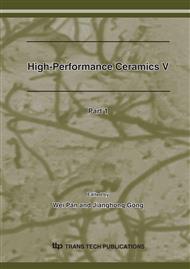p.778
p.781
p.784
p.787
p.790
p.794
p.797
p.800
p.803
Fabrication of the Monolithic Silica Aerogels Using Sodium Silicate and its Network Strengthening
Abstract:
Silica wet gels were prepared from water glass (29 wt.% SiO2) by using Amberlite as a ion exchange resin. After washing in distilled water, the wet gels were further aged in a solution of TEOS/EtOH to strengthen the 3-dimensional network structure. With the increasing TEOS content in aging solution, BET surface area and porosity of the ambient dried silica aerogel were decreased, and the average pore diameter was decreased from 30nm to 10nm. Also, higher density and compressive strength were obtained in case of higher TEOS content. This is due to the precipitation of SiO2 nano particle by TEOS. Hence, TEOS addition plays an important role in both strengthening and increasing stiffness of silica wet gel network. By adding 30 vol.% TEOS, a crack-free monolithic silica aerogel tiles were obtained and its density, compressive strength, and thermal conductivity were shown 0.232 g/cm3, 7.3 MPa, and 0.029 W/mK, respectively.
Info:
Periodical:
Pages:
790-793
Citation:
Online since:
February 2008
Authors:
Keywords:
Price:
Сopyright:
© 2008 Trans Tech Publications Ltd. All Rights Reserved
Share:
Citation:


